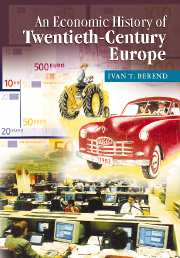 An Economic History of Twentieth-Century Europe
An Economic History of Twentieth-Century Europe Published online by Cambridge University Press: 05 June 2012
The rise of Britain and the laissez-faire system
The “long” nineteenth century, from the 1770s–80s to 1914, was the most spectacular period of economic change in Europe. The British Industrial Revolution opened a new chapter of economic history. By the middle of the eighteenth century Britain had achieved the prerequisites for sustained economic growth. More than 1,000 miles of navigable canals and waterways, 300 Newcomen steam engines, a revolutionized agriculture, and dynamic proto-industrial development made Britain the center of world trade. Domestic markets played a dominant role during this period (Flinn, 1966: 62); only 5–9% of British output was exported during the eighteenth century. However, higher profits in foreign markets increased the role of exports to 10–12% (Bairoch, 1976: 196). Export activity, nevertheless, became the driving force of industry: during the first half of the eighteenth century the output of export industries increased by 76%, while output in other industries grew only 7%. The value of British exports doubled between 1700 and 1750, and then more than tripled by 1800. The leading textile industry by then exported half its output. Eric Hobsbawm concludes that the origins of British industrialization were rooted in foreign trade, especially with less developed areas such as India and other colonies (Hobsbawm, 1968: 49).
In the early eighteenth century, Britain defended its domestic market in a traditional mercantilist way. For example, the so-called Calico Law banned the imports of Indian cotton goods. Exports flourished, especially in the leading textile sector.
To save this book to your Kindle, first ensure no-reply@cambridge.org is added to your Approved Personal Document E-mail List under your Personal Document Settings on the Manage Your Content and Devices page of your Amazon account. Then enter the ‘name’ part of your Kindle email address below. Find out more about saving to your Kindle.
Note you can select to save to either the @free.kindle.com or @kindle.com variations. ‘@free.kindle.com’ emails are free but can only be saved to your device when it is connected to wi-fi. ‘@kindle.com’ emails can be delivered even when you are not connected to wi-fi, but note that service fees apply.
Find out more about the Kindle Personal Document Service.
To save content items to your account, please confirm that you agree to abide by our usage policies. If this is the first time you use this feature, you will be asked to authorise Cambridge Core to connect with your account. Find out more about saving content to Dropbox.
To save content items to your account, please confirm that you agree to abide by our usage policies. If this is the first time you use this feature, you will be asked to authorise Cambridge Core to connect with your account. Find out more about saving content to Google Drive.